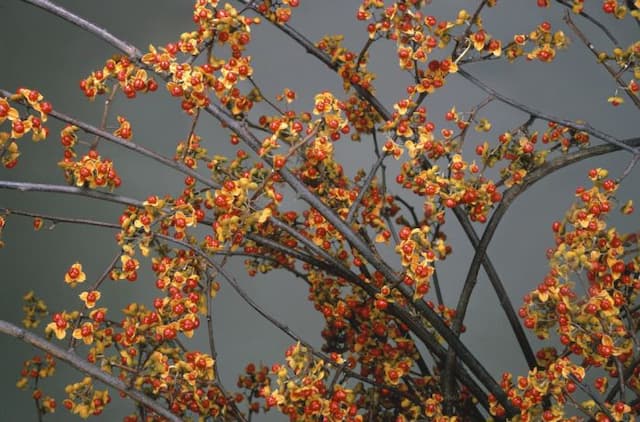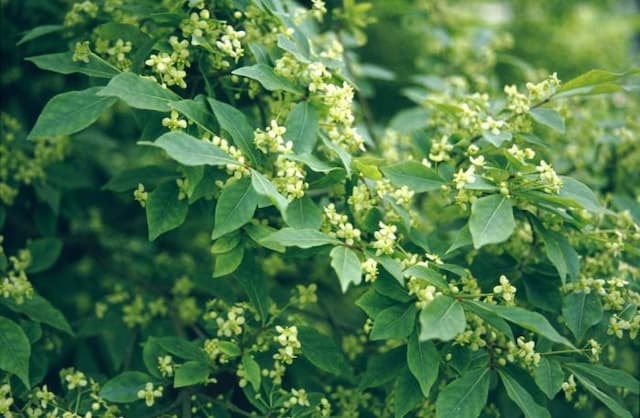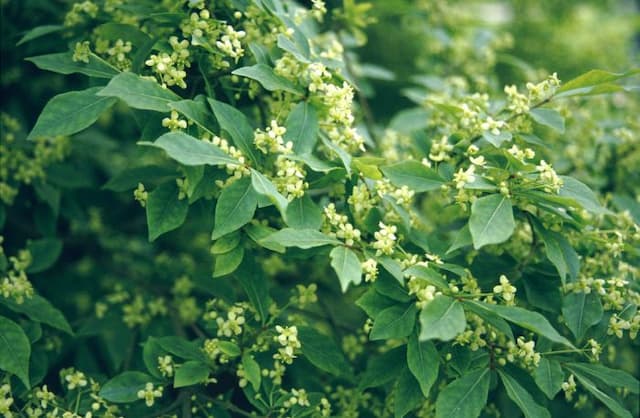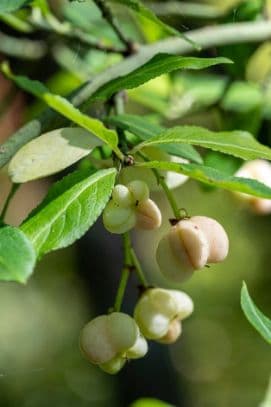Wintercreeper Euonymus fortunei Blondy = 'Interbolwi' (v)
![spindle [Blondy]](/_next/image?url=https%3A%2F%2Fplants-admin.emdemapps.com%2Fimages%2Fplants%2F%2Fimages%2F604b642f54add.png&w=3840&q=75)
ABOUT
The plant in question, commonly known as Wintercreeper 'Blondy', features a striking variegated foliage. The leaves are characterized by a bold contrast between a golden-yellow to light green center and darker green margins, creating a vivid and eye-catching appearance. The foliage maintains its vibrant color throughout the year, making it a staple for adding year-round interest to any garden or landscape. The leaves are oval to elliptical in shape, typically with smooth edges, and are arranged opposite each other along the stems, which lends the plant a dense and compact texture. The stems of Wintercreeper 'Blondy' are woody and may take on a trailing or climbing habit, allowing it to spread gracefully over the ground or climb on supports, making it versatile in its use as either ground cover or a decorative climber. During the growing season, small, inconspicuous flowers may appear, but they are usually not the main attraction when compared to the showy foliage. Overall, Wintercreeper 'Blondy' is admired for its distinct, variegated leaves that provide a splash of color to shaded or partially sunlit areas of the garden.
About this plant
 Names
NamesSynonyms
Wintercreeper, Fortune's Spindle, Blondy Wintercreeper, Variegated Wintercreeper.
Common names
Euonymus fortunei Blondy 'Interbolwi' (v).
 Toxicity
ToxicityTo humans
Wintercreeper is known to be toxic if ingested by humans. The toxic components can cause symptoms such as nausea, vomiting, diarrhea, weakness, and in more severe cases, changes in heart rate or rhythm. Care should be taken to prevent accidental ingestion, especially by children, who may be attracted to its berries.
To pets
Wintercreeper is also toxic to pets, with symptoms of poisoning similar to those in humans. If a pet ingests any part of the plant, they may experience vomiting, diarrhea, abdominal pain, and sometimes weakness or heart abnormalities. It is important for pet owners to ensure their animals do not chew on or consume this plant to prevent potential poisoning.
 Characteristics
CharacteristicsLife cycle
Perennials
Foliage type
Evergreen
Color of leaves
Variegated
Height
3 feet (0.91 meters)
Spread
4 feet (1.22 meters)
Plant type
Shrub
Hardiness zones
5-9
Native area
East Asia
Benefits
 General Benefits
General Benefits- Easy to care for – Euonymus fortunei Blondy is low maintenance and can thrive with minimal care once established.
- Drought tolerance – It is quite resilient in dry conditions after it has been established, which is beneficial in areas subject to water restrictions or dry climates.
- Year-round interest – This plant offers attractive foliage throughout the year, adding continual appeal to the landscape.
- Versatile use – It can be used in various garden settings, including as a ground cover, part of a border, or as an ornamental feature.
- Adaptable to pruning – The Wintercreeper can be easily shaped and pruned to maintain a desired size or form.
- Tolerates various soil types – It can grow in a wide range of soil conditions, which makes it suitable for different garden situations.
- Cold hardiness – It can survive in colder climates, making it an excellent choice for landscapes in regions with cold winters.
- Deer resistance – The plant is not a preferred food source for deer, which helps to reduce damage in gardens where deer are present.
- Attracts wildlife – While deer may avoid it, Wintercreeper can attract birds and provide them with shelter.
- Variegated foliage – The contrasting colors of its leaves add visual interest and depth to garden designs.
 Medical Properties
Medical PropertiesThis plant is not used for medical purposes.
 Air-purifying Qualities
Air-purifying QualitiesThis plant is not specifically known for air purifying qualities.
 Other Uses
Other Uses- Wintergreen Fortune's Spindle can be used as a dye plant, providing a range of colors from the bark and leaves when properly processed.
- The dense foliage of Wintergreen Fortune's Spindle is ideal for creating intricate topiary designs in formal gardens.
- Due to its hardiness, Wintergreen Fortune's Spindle is useful for erosion control on slopes and banks.
- The wood of Wintergreen Fortune's Spindle, although not commonly used, can be crafted into small wooden objects or tools.
- Wintergreen Fortune's Spindle can be planted to form a living barrier or hedge, providing privacy and wind protection.
- The plant is sometimes used as a host for cultivating certain species of beneficial insects, like ladybugs that control pests.
- Wintergreen Fortune's Spindle leaves can be used in educational settings, such as schools or workshops, to teach about leaf variegation and plant adaptation.
- During festive seasons, the variegated leaves can be included in floral arrangements and wreaths for natural decor.
- With its adaptable nature, Wintergreen Fortune's Spindle can be grown in containers as part of urban or balcony gardening.
- Wintergreen Fortune's Spindle's dense growth habit makes it suitable for creating intricate garden mazes or labyrinth designs.
Interesting Facts
 Feng Shui
Feng ShuiThe Wintercreeper is not used in Feng Shui practice.
 Zodiac Sign Compitability
Zodiac Sign CompitabilityThe Wintercreeper is not used in astrology practice.
 Plant Symbolism
Plant Symbolism- Adaptability: Euonymus fortunei Blondy, commonly known as Wintercreeper, often symbolizes the ability to thrive in various conditions due to its nature as a versatile and hardy plant.
- Resilience: Similar to its adaptability, the Wintercreeper represents durability and the capacity to recover quickly from difficulties because of its robustness and evergreen qualities.
- Growth: The spreading habit of Wintercreeper signifies continual growth and expansion, making it a symbol for personal or professional development.
- Protection: As a plant that can form dense mats, Wintercreeper is sometimes associated with providing shelter and protection, symbolizing safety and refuge.
 Water
WaterThe Wintercreeper 'Blondy' should be watered thoroughly, allowing the soil to become slightly dry between waterings. In general, watering once a week is a good rule of thumb, but this may vary depending on climate and soil conditions. During hotter months or in drier climates, it may require more frequent watering, perhaps twice a week. Use about half a gallon of water for smaller plants and up to 1-2 gallons for larger specimens each time you water, ensuring even soil moisture without waterlogging.
 Light
LightWintercreeper 'Blondy' thrives best in partial to full sun. It can tolerate full sun conditions but prefers some afternoon shade to protect its foliage from scorching. The ideal spot for this plant would be where it can get morning sun and partial shade during the intense afternoon heat, ensuring the variegation of the leaves remains vibrant.
 Temperature
TemperatureWintercreeper 'Blondy' is hardy and can tolerate a range of temperatures, surviving minimums of around -10 to 0°F and maximums up to 90°F. The ideal temperature range for this plant is between 60 and 80°F. It is important to provide protection if temperatures dip below the freezing point, as extreme cold can damage the plant.
 Pruning
PruningPruning Wintercreeper 'Blondy' helps maintain its desired shape and size, encourages healthy growth, and removes any damaged or diseased foliage. Prune it in late winter or early spring before new growth begins. Occasional light pruning may be done throughout the year to tidy the plant. It's generally not necessary to prune more than once annually, unless shaping is required or to clear out dead wood.
 Cleaning
CleaningAs needed
 Soil
SoilWintercreeper 'Blondy' thrives in well-draining, loamy soil with peat moss. Aim for a soil pH of 6.0 to 7.5, which is slightly acidic to neutral.
 Repotting
RepottingWintercreeper 'Blondy' should be repotted every 2-3 years to ensure healthy growth and to refresh the soil mix.
 Humidity & Misting
Humidity & MistingWintercreeper 'Blondy' prefers moderate humidity levels but is quite adaptable to different environments except for extremely dry conditions.
 Suitable locations
Suitable locationsIndoor
Provide bright, indirect light and well-draining soil.
Outdoor
Place in partial to full sun and well-draining soil.
Hardiness zone
5-9 USDA
 Life cycle
Life cycleEuonymus fortunei Blondy, commonly known as Wintercreeper 'Blondy', begins its life as a seed which germinates in spring if conditions are favorable. After germination, the seedling emerges and establishes itself, developing a root system and sprouting its first leaves. As a rapidly growing evergreen, it progresses to the vegetative stage, during which it produces distinctive green and yellow variegated foliage and begins to spread, often forming a dense ground cover or climbing nearby structures with its aerial rootlets. After reaching maturity, which can take several years, it starts to flower, producing inconspicuous greenish-white blooms typically in early summer. Following pollination, which is often accomplished by insects, it develops fruit; small, pink to red capsules that open to reveal orange seeds. These seeds, once dispersed, can give rise to new Wintercreeper plants, thus completing the life cycle.
 Propogation
PropogationPropogation time
Spring-Early Summer
Euonymus fortunei 'Blondy', also known as the Wintercreeper, is most commonly propagated through stem cuttings. This method is usually undertaken in the summer when the plant is actively growing. To propagate from cuttings, a gardener would take a 4 to 6-inch (10 to 15 cm) section of stem from a healthy parent plant, making sure the cutting includes at least a couple of sets of leaves. The lower leaves are removed, and the cut end is dipped in rooting hormone to encourage root development. The cutting is then planted in a pot filled with a mix of peat and perlite, making sure to moisten the soil first. The pot is placed in a warm, well-lit area, but out of direct sunlight, and the soil is kept consistently moist until the cutting roots, which typically takes a few weeks. After roots have established, the new plant can be transplanted to its final location.








